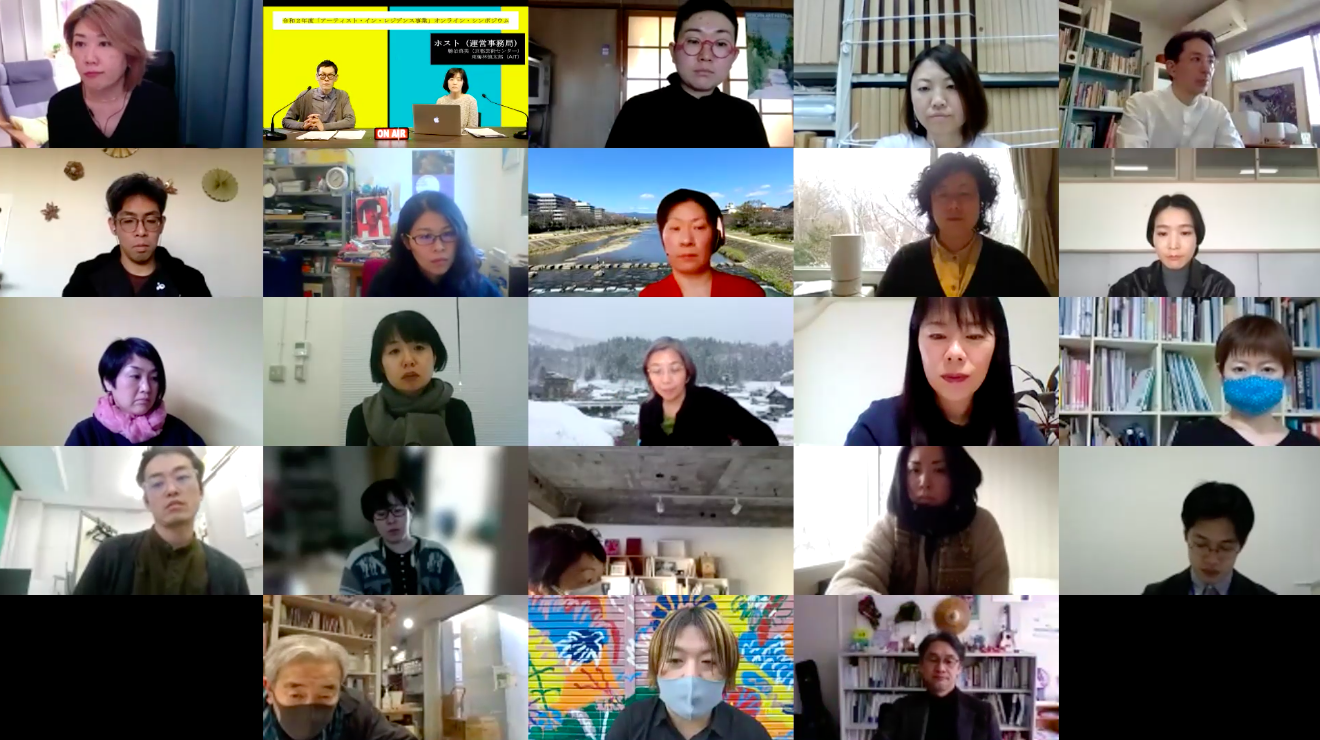

On Thursday, March 18, 2021, an online symposium hosted by the Agency for Cultural Affairs was held for participants comprising domestic artist-in-residence (hereafter AIR) organizations, artists participating in AIR programs in Japan and overseas, and organizations and individuals with an interest in AIR. The symposium was co-sponsored by the City of Kyoto, and managed by Kyoto Art Center (Kyoto Arts and Culture Foundation) and non-profit organization Arts Initiative Tokyo (AIT). The Agency for Cultural Affairs has been providing financial support to domestic organizations that implement AIR since 2011.

Taken during a general summary of the online symposium in which the participants, administrators, and facilitators of opinion exchange meetings gathered.
Since the beginning of 2020, the global spread of the new coronavirus has affected not only daily life but also various cultural and artistic activities from the perspective of preventing the spread of infection. Among AIR, which are designed to promote exchange, deepen creative activities, and revitalize local communities through the international movement of artists and other creatives, the implementation of restrictions on international travel led some to cancel or postpone their programs. Many others adopted ICT-based “online residencies” and other such programs, which were implemented through trial and error by respective AIR organizers. The aim of this symposium was to provide an opportunity for those involved in AIR, which are still engaged in a process of testing methods, to learn about the efforts of various organizations and individuals, and to deepen ideas about how to continue their activities by sharing with the whole community the challenges posed and possibilities created by the pandemic in relation to AIR. In addition, the symposium also served to aid the building of a network that can be consulted in times of difficulty.
In the first session of the symposium, local governments and organizations that are implementing AIR introduced case studies under the theme of “Residencies and Resilience” (i.e., the ability to recover and overcome difficulties in a flexible manner). Talks were given by Mitsuhiro Susaki (director of Ise City Industry and Tourism Department) about the Ise City Creators’ Workation project, and by Junpei Mori (director of PARADISE AIR in Matsudo City), about a program PARADISE AIR organized in rapid response to the situation under the coronavirus pandemic. The talk was moderated by Arata Hasegawa, an independent curator and guest curator of PARADISE AIR.
The project presented by Ise City is based on an AIR project organized with the British Council in FY2019 for the purpose of inbound (overseas visitors to Japan) travel. Focusing on the high level of interest in Ise from Europe and the United States, the project has also promoted exchanges between regional and British artists by providing visitors with the experience of traditional culture rooted in the region. Based on this experience, the city utilized a grant from the government to implement the Creators’ Workation project in FY2020 in order to address the crisis of plummeting tourist numbers in relation to the ryokan (Japanese inn) industry due to the effects of the new coronavirus infection.
On the other hand, PARADISE AIR, which has been active since 2013, is a facility where approximately 60 creators take up residency every year, but the declaration of the state of emergency led the organizers to temporarily halt hosting artists. Taking advantage of the situation after the declaration was lifted, a program called the MATSUDO QOL AWARD was launched, offering residencies only to artists living within a 60-minute radius of Matsudo. By “isolating” artists within a short distance of PARADISE AIR who had not previously been considered for the residency and by considering the participants’ “quality of life,” the program helped to provide an environment in which they could concentrate on their creative activities. In addition, following a redefinition of the network they had cultivated over the past seven years of continuous activities as a “Knot,” PARADISE AIR reexamined its relations with domestic and international AIR organizations in an attempt to find the best way to connect with each organization under the circumstances.
When an artist visits a community or establishes a relationship with it online, certain characteristics of the place, which had previously gone unnoticed by local residents and AIR organizers, may become visible. In addition, by gaining a connection with the area and its people, a sense of attachment and feelings about the place will be generated, leading to an ongoing relationship even after the residency and exchange has finished. Accepting the current situation under the pandemic, AIR are doing what they can in a positive and flexible manner. The resilience of residences will surely be built on the relationships created through such an attitude, allowing them to function as places of refuge where people can discuss and share their problems.
In the second session, 20 AIR organizations from among grant recipients of the Agency for Cultural Affairs’ FY2020 Program to Promote International Cultural Exchange Through the Support of Artist in Residence Activities acted as the main speakers in a 60-minute opinion exchange joined by other domestic organizations implementing AIR and general audience members.
With regard to AIR programs targeting artists based in Japan, since the lifting of the state of emergency, the national government and local governments have developed guidance and guidelines on infection prevention, which has granted mobility to artists and allowed some programs to be implemented without major changes. However, changes were seen in the reactions of local residents to the arrival of artists from outside respective regions, but rather than negative responses, examples were given of increased expectations for artists visiting these regions amidst restrictions to, and scaling down of, cultural and artistic activities in general. There were also organizations that flexibly shifted their programs to support artists in the prefecture they are based by offering studio residencies, as well as through the provision of a production environment and expenses. There were also attempts to use video to disseminate the artists’ ideas to a wider audience, while mention was made of the significance of producing output even when incomplete.
The majority of AIR programs that invited international artists attempted online forms of communication. Underlying this trend was the reality that AIR had been unable to host any artists in the previous year, while AIR programs such as microresidencies that operate on a small scale experienced financial difficulties due to the cancellation of overseas artists’ residency plans, which had a significant impact on the operation of their facilities. However, the time that would normally have been given to the care of artists was used constructively to follow up on and archive previously realized AIR projects, to continue to disseminate information about Japanese culture and AIR to artists, or to establish pandemic study groups with AIR through international networks in order to analyze the situation for the future. AmongAIR that conducted exchanges and research using tools such as Zoom, various difficulties were identified, such as that of sharing physical expressive forms—especially in the performing arts field—online, as well as the problems of time difference, online fatigue, and the high level of language skills and literacy required for smooth communication. The experience of having online activities hacked and events vandalized was also reported.
In the past, AIR were operated on the basis of relationships centered on the mobility of artists, but with the shift to online communication that allows constant connection between host and artist, it has become easier to implement long-term projects. It has also become easier to develop programs in which collaborations between the artist and AIR are divided into multiple installments through which the process can be carefully followed while securing sufficient time for research and production at the artists’ normal place of activity. In addition, it was noticeable that many AIR operated by public institutions position the online program as a preparatory period before the residency, and are considering to invite artists after travel overseas can safely resume.
This symposium highlighted the fact that everyone involved in AIR has been affected in some way by the travel restrictions. However, I was left with the impression that there is no wavering in the expectation and trust placed inAIR to connect artists with regional areas and its residents through their programs, and that expressive forms will be born out of the connections artists make with the regions AIR are located. The increasing complexity of methods and timelines needed to implement AIR also raises questions about their very significance and the best way for each artist to interact with them. This experience and the resulting network will surely become a valuable legacy for each of us even after the pandemic.
*Titles in the text are accurate at the time of the event.
Yuka Keino, Curator of Aomori Contemporary Art Centre [ACAC]
Born in 1989. Keino worked for Visual Arts Department and Social Contribution Center (now NPO Arts Center Akita) at Akita University of Art and for Museum of Samoa (National Museum in Independent States of Samoa) before assuming her current position from April 2019. At Aomori Contemporary Art Centre, she curates and produces exhibitions based on local research and site-specific productions, and reorganizes the AIR program (co-curation) to further draw out the potential of the public facility.
Translation: Jaime Humphreys
2024.7.9Acasă la Hundorf Residency JournalArtist : Miyake Suzuko
2023.5.14AIR and I, 09 : Mentoring Artists for Women’s Art (MAWA) Residence Report